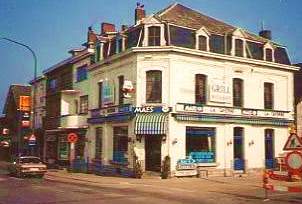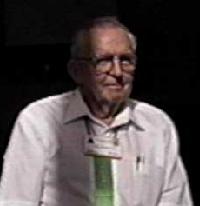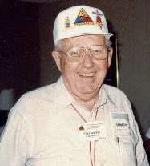


I have always been intriged about the battle in around Hotton, Belgium. This picture was taken by my son Chip in March 1993. The picture of Leroy Hanneman was made in 1990 during an interview. and picture of Jack Warden made in 1996 at time of interview. It is on the North side of the bridge on Rue Haute. I went down Rue Haute with a picture of some GIs and a young girl on a tank. I knocked on the door of the house in the background of the picture. A lady came to the door and took the picture I held up, and she got very excited and said "It is me". The picture had been taken almost 50 years ago. One of the GIs in the picture was Lt. Jack Warden. Jack Warden had sent me his story and the picture from Texas. Jack had always been miffed that his platoon had not been reconized for the part they played in rescuing some 23rd. Engineers
and then holding off a Germany attack to take the town on December 24th, 1944. I had found flaws in the report by Maj. Fickessen. Then just recently while reviewing some tape interviews, I came across an interview by LeRoy Hanneman of the 23rd Engineers, saying he was in Hotton and some of their men had been traped in the basements. Lt Jack Warden's small Task Force including his platoon of B Company of the 36th AR. and the tanks of Lt. Smith and Lt. Modrack should have been reconized in the report by Maj. Fickerson.
Below is the reported interview by Maj. Ficherson, and personal interviews with LeRoy Hanneman, and Lt. Jack warden.
DEFENSE OF HOTTON
3rd Armd Div, 23 RB Eng Bn, 20-24 Dec 1944
Interview: Major Jack Fickessen, Ex. Off 23rd Eng Bn
Bra, Belgium, 7 Jan 1945
(Note: This interview designed to supplement accounts, of Hq
Co 3d AD, and 143d Signal Co.)
20 December.
At Hotton, the engineers had Hq of Div Eng, approximately 80 men, with E Co, 23rd Eng Bn of 120 men. Twenty-five men of B Company were south of the river.
21 December.
The enemy attack began after the engineers had finished breakfast. At 0900, the 25 men sent to the southeast of town, some 500 yards, to set up an outpost and observe. This unit received no opposition.
As far as the town itself, little groups of enemy infantry and a Mk IV pulled into town along the Soy road, and shot up a light and medium tank on this road east of the center OR in Hotton. The tank received fire from two bazookas hastily manned by the engineers in the vicinity, and after the third round, the crew bailed out. One was killed and others fled. Each was partly clothed in American uniform. Enemy infantry was trying to come along behind. It was an estimated platoon strength, and was held down by fire. The second Mk V tanks came in behind the road of houses bordering the north side of the highway and stopped just short of the north road. It also was fired on by a bazooka pair at the CR and another from behind the building to the west. As the tank turned to back around, a tank south of the river fired at it from the rear and knocked it out. The enemy infantry got into the buildings at the east of town and were not dislodged.
During the early afternoon the enemy activity died down. The officers were rounded up, the defense was more carefully organized, and the platoon of medium tanks (G Co, 32AR) and a platoon of light tanks (C Co, 33AR ) and a platoon of infantry (B Co, 36th AIR), blocks and patrols were set up in the town. The force was to hold at all costs. Likewise, E Co 23rd Bn was sent out of the town by the northwest route. A listening post (six men and some mines) was set up northeast at (377884).
22 December.
About 1900 to 1930, movement to the east was observed near the three houses (375882) of tanks and infantry. Then three prongs of an attack were launched, with the tanks supporting by direct fire on the buildings in the town. Mortar fire was likewise heavy on the defenders. One prong came down from the north, another from the northeast, and the third up the road from the east. The north group was repulsed, but the second group cut the road. The third pushed into the houses farther, but did not advance very far. From prisoners' reports, it was understood that three companies, totalling 250 men, took part in the attack. Apparently, during the day, the enemy to the east of town had received reinforcements from the column coming up between TF Hogan and TF Orr.
In spite of the limited success of the enemy attack, he withdrew during the night, approximately 2400.
During the attack, a request was made to Lt Col Williams, 2nd Bn, 334th Infantry, for assistance. Since the river was his boundary, he stated that he could not send men north of it. However the 83rd Div artillery fired on the three houses east of town, hitting a Mk IV and a MK V tank. A company of the battalion south of the river aided with mortar fire, particularly in firing illuminating shells.
23 December.
Patrols sent out in the morning found the enemy out of the town. Some patrol activity was engaged in but, otherwise, the day was quiet. Artillery and mortar fire continued to fall on the town.
24 December.
At 0500, a company of the 509th Para Bn arrived in Hotton. The company tried to go east and clear out the houses at the east edge of town, which were still held by the enemy. However, that day the paratroopers did not get out of the town.
25 December.
At 0100, civilians in the east of town reported that the enemy was leaving to go back down to the southwest. And at 0930, the 509th Bn arrived from the east, making contact with the company in the town.
Part of the force at Hotton was withdrawn to Barvaux, while some of the other headquarters left the following day, when elements of the 7th Inf Div took over the sector.
LeROY HANNAMEN

